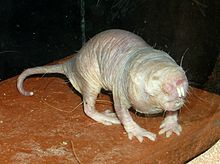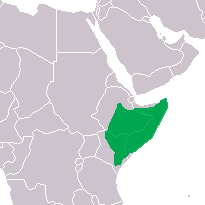Heterocephalidae
| Naked mole-rat Temporal range: Early Pliocene - Recent |
|
|---|---|
 |
|
| Scientific classification | |
| Kingdom: | Animalia |
| Phylum: | Chordata |
| Class: | Mammalia |
| Order: | Rodentia |
| Family: |
Heterocephalidae Landry, 1957; Patterson, 2014 |
| Genus: |
Heterocephalus Rüppell, 1842 |
| Species: | H. glaber |
| Binomial name | |
|
Heterocephalus glaber Rüppell, 1842 |
|
 |
|
| Distribution of the naked mole-rat | |
The naked mole-rat (Heterocephalus glaber), also known as the sand puppy or desert mole rat, is a burrowing rodent closely related to the blesmols, native to parts of East Africa, and is the only species currently classified in the genus Heterocephalus. The genus is classified as being in the family Bathyergidae or in its own family, Heterocephalidae. The naked mole-rat, the Damaraland mole-rat, and Mechow's mole-rat are eusocial mammals, the highest classification of sociality. It has a highly unusual set of physical traits that enable it to thrive in an otherwise harsh underground environment; it is the only mammalian thermoconformer, almost entirely ectothermic (cold-blooded) in how it regulates body temperature.
The mole rat lacks pain sensitivity in its skin, and has very low metabolic and respiratory rates. While formerly considered to belong to the same family as other African mole-rats, the Bathyergidae, more recent investigation places the naked mole-rat in a separate family, Heterocephalidae. The mole rat is also remarkable for its longevity and its resistance to cancer and oxygen deprivation.
Typical individuals are 8 to 10 cm (3 to 4 in) long and weigh 30 to 35 grams (1.1 to 1.2 oz). Queens are larger and may weigh well over 50 grams (1.8 oz), the largest reaching 80 grams (2.8 oz). They are well-adapted to their underground existence. Their eyes are quite small, and their visual acuity is poor. Their legs are thin and short; however, they are highly adept at moving underground and can move backward as fast as they can move forward. Their large, protruding teeth are used to dig and their lips are sealed just behind the teeth, preventing soil from filling their mouths while digging. About a quarter of their musculature is used in the closing of their jaws while they dig—about the same proportion that is utilized in the human leg. They have little hair (hence the common name) and wrinkled pink or yellowish skin. They lack an insulating layer in the skin.
...
Wikipedia

